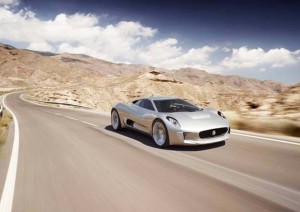Jaguar is charging into the Paris Motor Show – quite literally – with an electric supercar concept dubbed the C-X75.
Using four separate wheel motors to produce a combined 770 horsepower and a blistering 1,180 lb-ft of torque, Jaguar claims the striking 2-seater will be capable of hitting 205 mph, and launching from 0 to 100 kmh (0 to 62.5 mph) in just 3.4 seconds.
The Jaguar C-X75 differs from some other recent battery supercar concepts in that it has an onboard power source to keep the vehicle going once its batteries run down.
The sleekly aerodynamic C-X75 concept, meanwhile, is designed to showcase the British marque’s new design language, according to Mike O’Driscoll, Jaguar’s Managing Director.
“The C-X75 is a tribute to the people who shaped the iconic Jaguars that are revered to this day,” said O’Driscoll. “By making it an innovative test-bed for the technologies of tomorrow, it also ensures that our reputation for engineering excellence will continue for another 75 years and beyond.”
Though it might not seem initially obvious, the new Jaguar supercar concept has something in common with the soon-to-launch Chevrolet Volt.
The Jaguar concept has a 68 mile range on battery power, the maker claims, though that obviously will shrink substantially if the C-X75 is pushed to its limits. But unlike some other recent battery supercar prototypes, such as the Audi eTron and Mercedes-Benz SLS battery car, the British offering will be able to keep going even after its lithium-ion cells are drained.
The Jaguar C-X75 has a pair of onboard micro-turbines that spin at 80,000 RPM and which can generate enough electricity to keep the supercar performing at peak. In normal operations, the company claims the car will get as much as 560 miles on a combination of fully-charged batteries and a tank of gasoline.
Each turbine weighs just 77 pounds and can produce 94 horsepower.
The choice of individual wheel motors gives the C-X75 the electrical equivalent of vectoring all-wheel-drive. That eliminates the weight and complexity of a conventional, mechanical AWD system. But it allows the digital control system to constantly vary power to each wheel for traction-assisted steering.
Notably, the show car is expected to produce just 28 grams of CO2 per kilometer – and no emissions at all in battery mode.
The body of the Jaguar C-X75 emphasizes aerodynamics with a variety of high-tech touches. The front grille and brake cooling vents only open when needed, for example. Rear vertical control surfaces automatically deploy to maximize stability by actively directing airflow. The rear carbon fiber diffuser, meanwhile, includes an active airfoil that automatically lowers as speed increases.
The interior of the C-X75 continues the high-tech theme. Taking a cue from the new Jaguar XJ, with its digital LCD-screen gauge cluster, the new concept supercar uses several high-resolution touch screens to display vehicle information.
According to a Jaguar release, “The design team combined designs from instrumentation in the new XJ saloon with those from fighter aircraft to create virtual 3D ‘gimbals’ around which the gauges wrap and rotate to provide status updates.”
The seats are attached to the bulkhead of the C-X75, race car-style.
For those charged up and ready to plunk down a deposit, there’s no sign that the C-X75 will serve any purpose other than as a design and engineering exercise.

